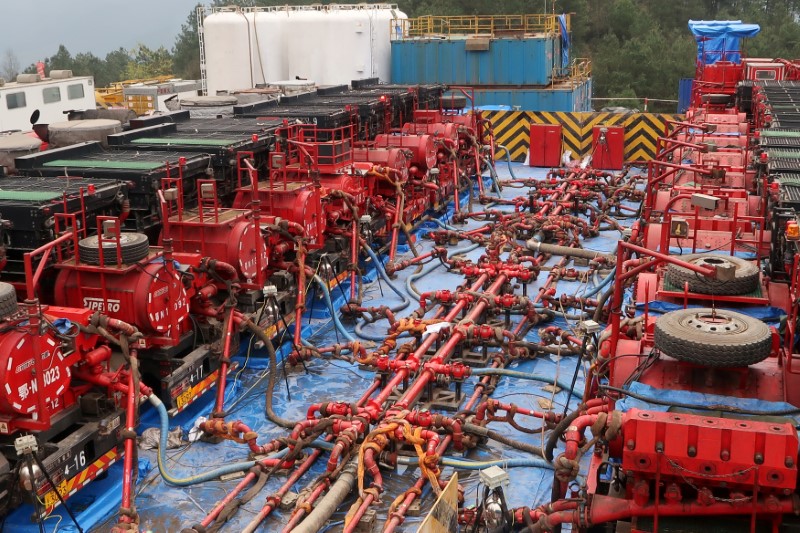By Chen Aizhu
CHONGQING, China (Reuters) - On a flattened mountaintop a two-and-half-hour drive south of Chongqing in southwest China, a fleet of towering, red fracking trucks pumps chemicals and sand into a 1,500-metre horizontal well deep under the ground.
The equipment was designed and built by China's state-owned energy major Sinopec, the result of a decades-long government drive to develop low-cost domestic technology to tap the country's vast shale gas resources buried in the region's mountainous terrain.
It is the latest key technology that China has learned to master.
Except for a handful of higher-end tools, Sinopec and a crop of independent companies make everything from trucks and pumps to drilling fluid and proppants - treated sand or man-made ceramics used to "prop" open a fracture to allow gas to escape.
"We're doing 95 percent or more of the service jobs ourselves. The amount of work handled by foreign firms is minimal," said Shi Yuanhui, a senior Sinopec service engineer.
The government-backed push, motivated in part by cost cutting amid the oil price slump of 2014, has seen international firms like oil services group Schlumberger (N:SLB), Halliburton (N:HAL) or Baker Hughes (N:GE) scale back operations in China.
Meanwhile, Chinese firms are starting to export equipment including pressure pumps, even to the home of the shale boom in the United States.
Over the past 8 years, the cost of building a well has nearly halved to an average of under 50 million yuan per well (5.92 million pounds), and drilling speed has improved by two-thirds to 45-60 days, according to interviews with state oil officials, equipment makers and service providers.
"China has over the years developed its unique practice that employs home-manufactured compact drilling equipment to suit the terrains, and improved greatly on drilling efficiency," said Lynn Lin of energy consultancy Wood Mackenzie.
Schlumberger and Baker Hughes declined to comment on their China shale business. Halliburton did not respond to a request for comment.
OUTPUT RISING
State energy giants Sinopec (HK:0386) and PetroChina (HK:0857) pumped 9 billion cubic metres (bcm) of shale gas in 2017, up from scratch a decade ago and equivalent to about 6 percent of the country's total natural gas production.
Still, the hilltop scene illustrates some of the problems facing the world's biggest energy consumer in exploiting its unconventional gas.
Unlike the flatter U.S. regions containing shale, Chinese firms operate in tricky environments, including mountainous, arid, remote and also highly populated regions, leading to higher costs.
China's shale is also buried deeper and is more fractured, making it difficult and expensive to extract.
China is expected to nearly double output to 17 bcm by 2020, according to Wood Mackenzie.
While below Beijing's 2020 target of 30 bcm, set out four years ago, and just a fraction of 474 bcm produced in the United States last year, domestic gas is a major focus as the country looks to ease its reliance on dirtier coal.
China's leading manufacturer of fracking equipment is Jianghan No.4 Machinery Plant, which accounts for more than half of the country's production of fracking trucks and pumps.
The firm, under the supervision of what was then the Ministry of Petroleum, bought several dozen U.S. fracking trucks in 1988 on condition the manufacturer allowed access to its technology, said a Jianghan marketing executive who declined to be named as he was not authorized to speak to media.
The know-how was initially applied to conventional wells before Jianghan No.4, now part of Sinopec, China's top shale gas firm, built the country's first shale fracker in 2012.
Baoji Machinery, a unit of state-run CNPC, and independent equipment builders Honghua Group (HK:0196) and Jereh Group (SZ:002353) have also expanded into shale, and are competing in new, more efficient electric-powered frackers.
Jereh and Honghua are also leading an export push, said company officials, competing with the likes of Halliburton.
Jereh exports trucks, pressure pumps and pipes, with total overseas sales making up half of its 3.2 billion yuan ($495 million) in revenue in 2017, a company spokeswoman said, declining to give a breakdown by country.
Lucrative export contracts will be needed as China's shale industry still struggles to make cash at home.
Sinopec has acknowledged it would be difficult to break even without government subsidies, currently at roughly 20 percent of well-head prices.[nB9N1O405G]
Helping increase efficiency, Chinese firms can now drill multiple wells at a single pad, known as "well factory" drilling.
They can also carry out extended horizontal fracturing up to 3,000 metres, Sinopec engineers said.
BARRIERS
The expertise will be needed if China is to make the most of its shale gas, estimated by the U.S. Energy Information Administration as the world's largest.
Western majors like Exxon Mobil (N:XOM), Royal Dutch Shell (L:RDSa), Total (PA:TOTF), ConocoPhillips (N:COP) and Chevron (N:CVX) largely abandoned China's shale scene after disappointing initial results.
Geologists at Sinopec said they have struggled to replicate a find like Fuling, the largest commercial field, a gas field similar, but smaller, to the hugely successful U.S. Marcellus formation.
There are also complaints that Sinopec's and PetroChina's domination is a barrier to future development, as these state behemoths hinder competition.
Only in late 2017, as shale drilling quickened on the back of rising oil prices (LCOc1), did the two majors start awarding service contracts to independent firms like SPT Energy (HK:1251), Anton Oilfield (HK:3337) and Honghua Group (HK:0196).
